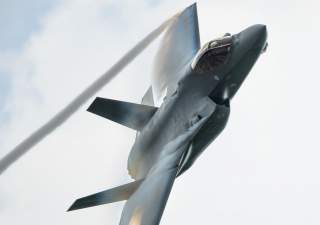Everything You Need to Know About the Difference Between the F-35A and F-35B
We've got the details.
The two and ten pylons on the wings also can carry less weight, so the F-35B has less overall munitions capability than the F-35A in that regard as well. However, it’s unlikely that the F-35B would want to operate at its max load in the first place given that it cannot vertically land with the maximum weight.
Often times, the F-35 has been colloquially referred to as one aircraft in the media, or various versions of the F-35 have been conflated with each other. However, despite their shared “program,” the standard F-35A and the VSTOL F-35B are very different and even feature different fuselages in addition to the additional complexity introduced in the B variant.
The primary difference between the two jets is that the B is less nimble in general. There are a multitude of reasons for this, many of which stem from the necessity for the B to have VSTOL capability.
The B variant is considerably “fatter” and bulkier than the F-35A as a result of the integration of the lift fan. This image overlays the fuselage shape of the F-35A over the F-35B, with the B being in orange. As a result of the increased frontal profile, the B has more drag.
(This first appeared in September 2018.)
This makes it slower to accelerate and harder to turn. Practically, the F-35B takes approximately eighteen more seconds to accelerate from Mach 0.8 to Mach 1.2 compared to the F-35A.
The increased profile and different weight also affects the potential turn rate, but practically, the F-35B is limited to pulling 7Gs maximum to avoid damage to internal components.
The B also has less internal fuel, but this is to be expected as it has additional parts that take up space in the fuselage that the A doesn’t. This limits its effective combat range versus the A, but it still is far superior to the other VSTOL aircraft that preceded it.
Weapons wise, there are a few small but important differences between the F-35A and F-35B. The most obvious one is the omission of the gun at the wing root on the F-35B due to the different fuselage shape.
Instead, the F-35B can mount a gun pod centerline under the fuselage with a stealthy fairing. This pod can carry an additional forty rounds versus the F-35A’s internal gun, and could potentially be more accurate as it’s directly center relative to the HUD and cockpit.
The weapons that the F-35B can carry internally are also different than the F-35A. Again, due to different requirements and fuselage shape, the internal weapon bays of the F-35B carry less weight than the F-35A.
The biggest implication is that the F-35B cannot carry the massive two-thousand-pound bombs stealthily, in order to employ them they must be hung from the external weapon pylons. Most of the United States’ “bunker buster” bombs weigh that much, so the F-35B would not be able to perform a stealthy mission against a deep hardened target, whereas the F-35A would.
The two and ten pylons on the wings also can carry less weight, so the F-35B has less overall munitions capability than the F-35A in that regard as well. However, it’s unlikely that the F-35B would want to operate at its max load in the first place given that it cannot vertically land with the maximum weight. If the F-35B took off with the maximum takeoff weight, it either would have to expend its stores in combat or jettison them before landing.
Recommended: What Will the Sixth-Generation Jet Fighter Look Like?
Recommended: Imagine a U.S. Air Force That Never Built the B-52 Bomber
Recommended: Russia's Next Big Military Sale - To Mexico?
Recommended: Would China Really Invade Taiwan?
All of these limitations may make it seem like the F-35B once in flight is by and large just a worse version of the F-35A. While this is true, it’s important to consider the roles of the aircraft. The F-35B is far closer in capability to the F-35A than the AV-8B was to the F-16C.
The AV-8B couldn’t even go supersonic, it had significantly fewer hardpoints, and its radar, while decent was worse than the F-16C. The F-35B, by comparison, is pretty much the same aircraft as the A, with just some limitations on maneuverability and weapons. It features the same top-notch sensor systems, radar, and datalink capabilities that the A brings to the table.
Charlie Gao studied Political and Computer Science at Grinnell College and is a frequent commentator on defense and national security issues.

